Do you like music? Then Fedora may have just what you’re looking for. This article introduces different music player apps that run on Fedora. You’re covered whether you have an extensive music library, a small one, or none at all. Here are four graphical application and one terminal-based music player that will have you jamming.
Quod Libet
Quod Libet is a complete manager for your large audio library. If you have an extensive audio library that you would like not just listen to, but also manage, Quod Libet might a be a good choice for you.
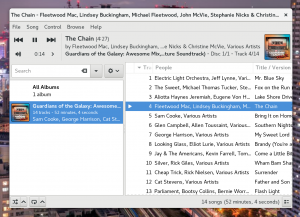
Quod Libet can import music from multiple locations on your disk, and allows you to edit tags of the audio files — so everything is under your control. As a bonus, there are various plugins available for anything from a simple equalizer to a last.fm sync. You can also search and play music directly from Soundcloud.
Quod Libet works great on HiDPI screens, and is available as an RPM in Fedora or on Flathub in case you run Silverblue. Install it using Gnome Software or the command line:
$ sudo dnf install quodlibet
Audacious
If you like a simple music player that could even look like the legendary Winamp, Audacious might be a good choice for you.
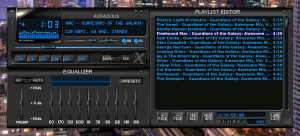
Audacious probably won’t manage all your music at once, but it works great if you like to organize your music as files. You can also export and import playlists without reorganizing the music files themselves.
As a bonus, you can make it look likeWinamp. To make it look the same as on the screenshot above, go to Settings / Appearance, select Winamp Classic Interface at the top, and choose the Refugee skin right below. And Bob’s your uncle!
Audacious is available as an RPM in Fedora, and can be installed using the Gnome Software app or the following command on the terminal:
$ sudo dnf install audacious
Lollypop
Lollypop is a music player that provides great integration with GNOME. If you enjoy how GNOME looks, and would like a music player that’s nicely integrated, Lollypop could be for you.
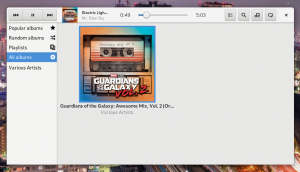
Apart from nice visual integration with the GNOME Shell, it woks nicely on HiDPI screens, and supports a dark theme.
As a bonus, Lollypop has an integrated cover art downloader, and a so-called Party Mode (the note button at the top-right corner) that selects and plays music automatically for you. It also integrates with online services such as last.fm or libre.fm.
Available as both an RPM in Fedora or a Flathub for your Silverblue workstation, install it using the Gnome Software app or using the terminal:
$ sudo dnf install lollypop
Gradio
What if you don’t own any music, but still like to listen to it? Or you just simply love radio? Then Gradio is here for you.
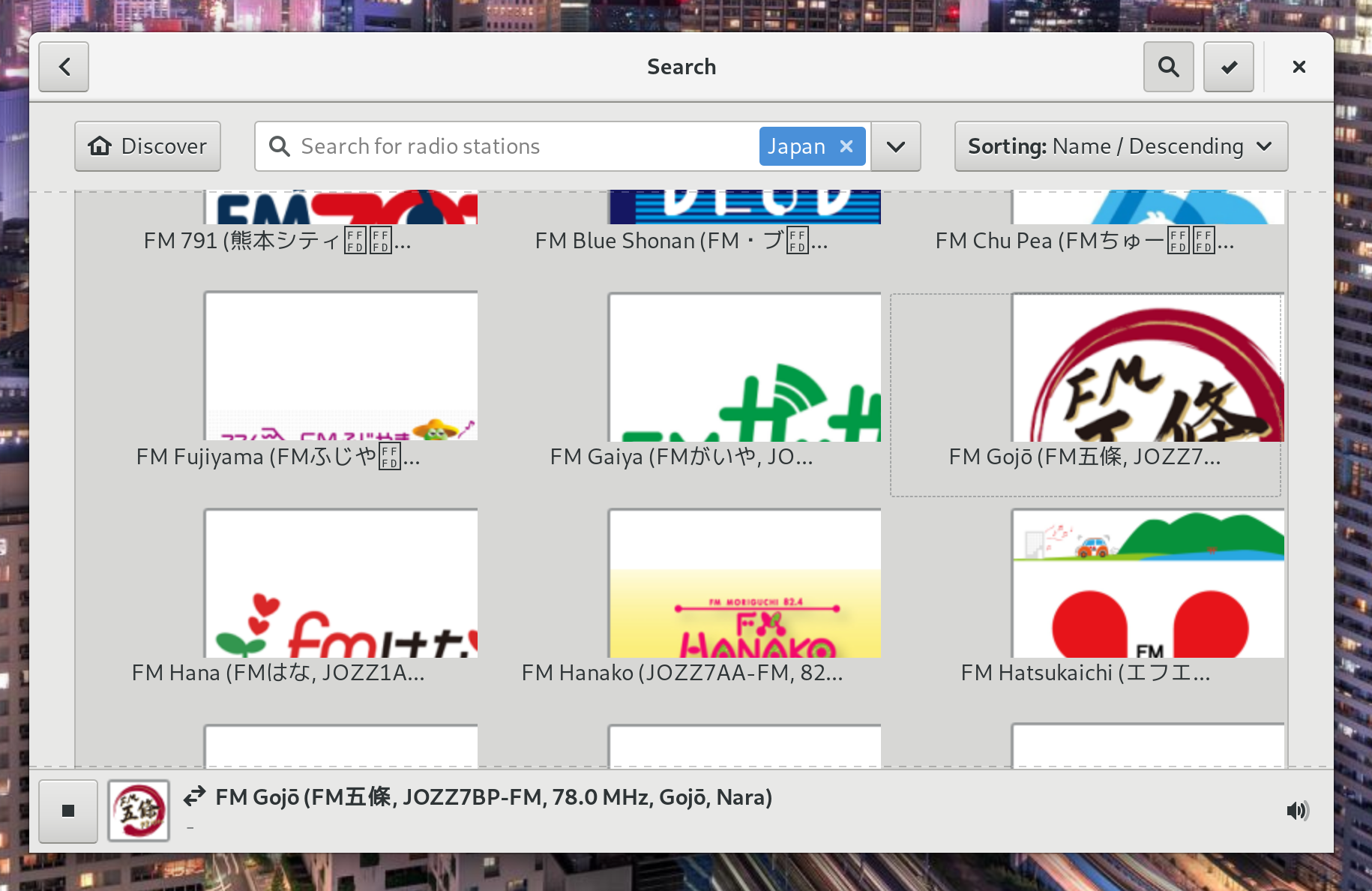
Gradio is a simple radio player that allows you to search and play internet radio stations. You can find them by country, language, or simply using search. As a bonus, it’s visually integrated into GNOME Shell, works great with HiDPI screens, and has an option for a dark theme.
Gradio is available on Flathub which works with both Fedora Workstation and Silverblue. Install it using the Gnome Software app.
sox
Do you like using the terminal instead, and listening to some music while you work? You don’t have to leave the terminal thanks to sox.
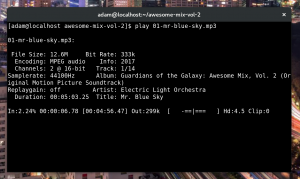
sox is a very simple, terminal-based music player. All you need to do is to run a command such as:
$ play file.mp3
…and sox will play it for you. Apart from individual audio files, sox also supports playlists in the m3u format.
As a bonus, because sox is a terminal-based application, you can run it over ssh. Do you have a home server with speakers attached to it? Or do you want to play music from a different computer? Try using it together with tmux, so you can keep listening even when the session closes.
sox is available in Fedora as an RPM. Install it by running:
$ sudo dnf install sox
Photo by Malte Wingen on Unsplash.






Martins M
Lollypop and Gradio screenshots look surprisingly similar 🙂
Clément Verna
Thanks, it is now updated 🙂
Anonymous Squirrel
Guayadeque is also worth mentioning because it”s a great player for really large music collections
Adam Šamalík
Thanks for the tip! 😉
Silvia
You left out Clementine and Amarok. Why?
Paul W. Frields
Because the article was 5 and not 7? Seriously, any finite list has to leave something out. Sorry it was the ones you thought of. But it had to happen to someone.
Luke
If you want a more comprehensive list of audio players, you can visit: https://en.wikipedia.org/wiki/Comparison_of_audio_player_software
it doesn’t contain Lollypop or Gradio however (SoX is listed elsewhere, even though I use it to play audio too, it’s usually used for audio modification)
zezinho
Yeah Clementine is incredible with it’s autoplay mode where you can add criterias. I use it daily at work since more than 10 years in my 15k files own music folder : I asked it to only play titles that were not played in the last month, and excluded child’s music genre.
Timothée F.
The
(curses UI, supports mpd) +
(music player daemon) combo is worth mentioning as well 🙂
Adam Šamalík
I’ve actually looked into that! Pretty interesting concept, especially if you have a home media server with speakers. I heard there’s also an Android app with the client?
Luke
yes there is: https://f-droid.org/en/packages/org.gateshipone.malp/
you can either control mpd or stream music directly to your phone
Robert
Recently I’ve discovered https://www.googleplaymusicdesktopplayer.com/ it is really nice interface for Google Music with last.fm scrobbling.
Michel Alexandre S.
And that’s also available via Flatpak:
https://flathub.org/apps/details/com.googleplaymusicdesktopplayer.GPMDP
Danniello
From this selection I prefer Audacious. WinAmp look is very nostalgic (ahhh that times when I dial-up via modem to download newer version of WinAmp plus some new skins:), but “more modern” and, in my opinion better, Windows referential is Foobar2000. By default Audacious works similar to Foobar2000 (but looking much better than default Foobar:) and is very configurable.
Unfortunately Audacious (in fact all mentioned players) have one very big issue – not supporting video stream as visualization…
I have quite big collection of music videos – it would be nice to have player that is capable to play audio and video. VLC or SMPlayer playlist capabilities are very limited compared to Audacious… Kodi is supporting audio and video, but it is rather Media Center for displaying on TV or something – as generic player is very uncomfortable to use…
There is available Audacious fork – Fauxdacious with video support, but I would like have such function upstream…
https://wildstar84.wordpress.com/fauxdacious/
samsung printer customer support
What I like the most about these applications is the vast collection of music of different genres. I am familiar with the Gradio and it is cool.
Audioliscious
I prefer to not listen to music on my PC since it is decidedly low-fi, even with expensive D/A audio cards, there is still a flotilla of bad stuff done to the analogue signal in the name of “new, better technologies”, or in the interest of space saving compression. So, if I’m working at my desktop, or my laptop, and I want to listen to music I use the Stereo, it’s a nifty little invention that (depending on gear) can afford you the benefit of hearing the music the way the artist wanted it to be heard.
James
Why don’t you get a USB DAC?
James
I use deadbeef myself. Maybe it’s not updated as often as it should be, but it’s got many interesting plugins such as Headerbar (which makes it look like a GNOME app) or lots of different visualisers. It’s a bit like foobar2000.
kim
the realm of free music apps for PC might be fading away with time, but still
Jalal
Thanks a lot
kevin
I recently found Museeks on github, it is a minimal cross-platform player utilizing electron https://github.com/KeitIG/museeks.
kevin
Adam, thanks for the suggestions. I tried Quod Libet today and I love the plugin architecture for adding only the features you need. I may have new music app for handling my large collection.
Adam Šamalík
Glad I could help!
gn0mish
I use Lollypop for all my music files and Gradio for the radio. They rank highest for me. Lollypop is the most attractive of all Gnome app in my opinion. It looks really great